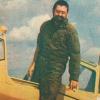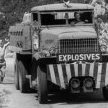

Dana Bell
-
Posts
402 -
Joined
-
Last visited
Content Type
Events
Profiles
Forums
Media Demo
Status Replies posted by Dana Bell
-
Hi Dana,
I have found two gif files on http://www.p40warhawk.com/Models/Technical/Technical.htm that show camo and paint schemes for export P-40 / H81-A2. These are super low resolution and unreadable. Do you know where I could obtain better copies?
http://www.p40warhawk.com/Models/Technical/Paint diogram 01.GIF
http://www.p40warhawk.com/Models/Technical/Paint diogram 02.GIF
Thanks, Nobby
-

Hi Nobby,
I have the drawings, but can't get to them this week. Drop me a line at [email protected] and I'll try to scan them for you next week...
Cheers,
Dana
-
-
Some 45 years ago I have seen the copy of "Scale Modeler" featuring the model of PBY-5 in so-called Asiatic fleet scheme invented by Admiral Hart men in Philippines. The owner of this copy - a long time friend of mine - died of heart attack few years ago and his widow destroyed (or simply thrown out) all his tremendous library...
Generally the aircraft followed the scheme well known from b&w pictures of PatWing 10 PBY-4s (and interpreted as 3 shades of blue-gray topsides plus a light grey bottom by Academy in their 1/72 PBY-4 kit), but if nobody knows for sure what the three topsides colors really were here one color seemed to be fixed - the Blue Gray as the PatWing 10 PBY-5s fighting over the Philippines and NEI in January 1942 were ex-VP-22 aircraft pictured a month before in Hawaii featuring then-standard M-485 over M-495 camouflage.
Do you mean that there was enough time and paint to apply the (otherwise standard for the PatWing 10) "Philippines camo" on the VP-22 aircraft recently acquired? Have you ever seen the early '70s Scale Modeler article mentioned above? Or maybe there are some photos confirming the scheme featured by the model depicted there?
Thank you in advance
-

Thanks for your question - you've touched on a subject that has interested me for many years - I'll give you my opinion, since I don't have proof either way...
First note is just a general note about M-485 and M-495 -- for many years modelers have thought those specs represented specific colors, which they didn't. M-485 was just a spec for camouflage lacquer, regardless of color; M-495 was the spec for camouflage dope. So Blue Gray lacquer applied to metal surfaces was M-485, while Blue Gray dope applied to fabric surfaces was M-495. The same was true of Light Gray lacquer and dope, and the insignia color lacquers and dope, black lacquers and dope, and so on. I mention this just to make sure we're talking the same language about these colors.
The earliest record I've seen of PatWing 10's Catalina camouflage was a reconnaissance photo dated 26 May 1941; all six PBYs in the photo were camouflaged in a disruptive pattern. PatWing 10 was in the Asiatic Fleet, whose ideas about camouflage were independent of the Pacific Fleet's (or Battles Force's) ideas. I believe that PatWing 10 might have used a version of a 1935 camouflage cited on page 31 of Jack Elliott's Monogram Guide Volume 1 - Dark Green-Yellow, Medium Blue-Green, and Light Purple-Blue. I've no proof, but those colors made sense for the murky Philippine waters, and that's what I think I'm seeing in the pix.
One last thing - you asked, "Do you mean..." but I'm afraid I don't have the memory I once had. (A bit too much time without oxygen a few years ago.) I'm not sure what I said, or when I said it, but I apologize for any confusion.
Cheers,
Dana
-
-
Hi Dana,
you are the undisputed expert on WW11 US aircraft colours so I have a (hopefully) simple question relating to a TBM-3 I'm building - what colour were the fire extinguishers?
-

Hi Tim,
I have to admit that I'm not really sure - there were a number of standard color changes during the war, some because there had been no standard, some because the Army and Navy needed to coordinate. I've never found the files on fire extinguishers (or, for that matter, oxygen bottles!) From what I've seen, many of the early extinguishers were brass or unpainted aluminum color, with the embossed manufacturer's name plate in black or some other contrasting color. By midwar, red seems to have been approved, though there could have been other colors used too.
Wish I had more to offer - I still have plans to spend a day tracking down the answers, but there's already so much else to do!
Cheers,
Dana
-



